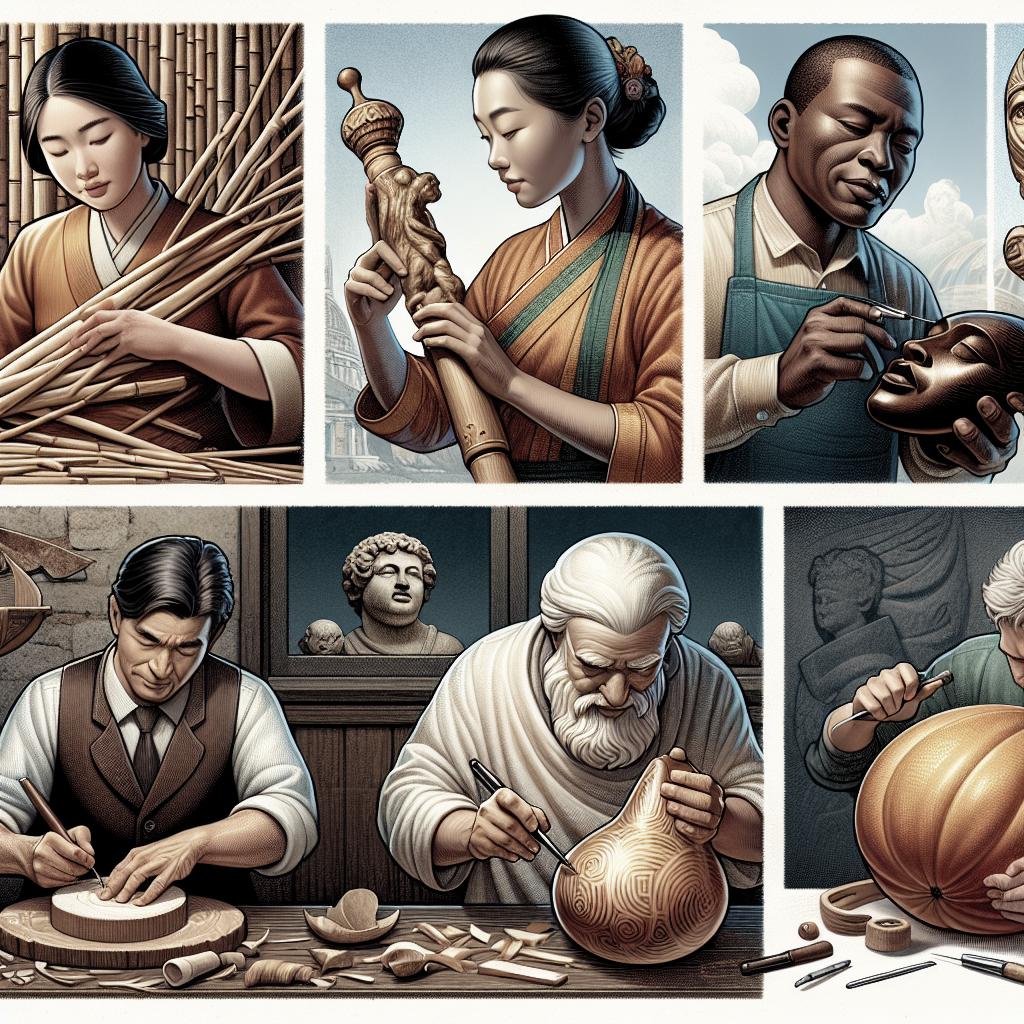“`html
Traditional Carving Techniques From Around the World
Art and craftsmanship have always been integral to human culture, reflecting the history, beliefs, and environment of each society. From delicate wood carvings to intricate textile weavings, traditional techniques from around the world offer a glimpse into the skills and creativity of artisans. This blog post explores various traditional media, their cultural importance, and their unique attributes. We will journey across continents, exploring traditional crafts from Asia to Oceania, showcasing not just the technical prowess but also the cultural narratives embedded within each piece of art. Join us as we honor these timeless traditions and the artisans who keep them alive.
Asia
Ikebana (Japan)
The Japanese art of Ikebana is more than just flower arrangement; it’s a disciplined art form in which nature and humanity are brought together. Ikebana necessitates an attentive mind, as practitioners must carefully consider color combinations, natural shape, and the placement of different materials.
Originating in Buddhist temples during the seventh century, Ikebana has evolved over the centuries while retaining its spiritual and philosophical roots. Practitioners focus not only on simple aesthetics but also on living in the present moment, embodying patience, discipline, and respect for natural beauty.
Batik (Indonesia)
Batik is a wax-resist dyeing technique that originates from Java, Indonesia. Known for its intricate and colorful patterns, Batik involves covering certain areas of cloth with wax to resist dye, creating stunning designs as a result.
Originally used for royal garments, Batik represents various cultural meanings and regional folklore. Today, it is an integral part of Indonesia’s cultural identity and is celebrated both in traditional ceremonies and modern fashion.
Thangka Painting (Tibet)
Thangka is a Tibetan Buddhist painting on cotton or silk, usually depicting a Buddhist deity or mandala. These intricate artworks are predominantly used during spiritual ceremonies and meditative practices.
The process of creating a Thangka is meditative and involves precise and laborious techniques, where the artist follows traditional iconographic rules. This craft serves as an important educational tool, conveying spiritual narratives and teachings.
Pottery (China)
Chinese pottery has a history spanning thousands of years, with each era bringing distinct styles and innovations. From blue and white porcelain to terracotta figurines, this craft reflects China’s diverse cultural heritage and technological advancements.
Combining beauty and functionality, Chinese pottery has been historically valuable for its artistry and utility, influencing ceramics worldwide. The delicate yet durable pottery pieces represent a significant cultural achievement of ancient China.
Woodblock Printing (Japan)
Japanese woodblock printing, or Ukiyo-e, is a multicolored print brought to life during the Edo period. Artists use hand-crafted woodblocks to layer colors and create intricate images, ranging from landscapes to scenes from The Tale of Genji.
Ukiyo-e remains a cherished art form for its narrative strength and aesthetic appeal, contributing to Japan’s cultural export. Many prints, including works from Hokusai and Hiroshige, continue to captivate art enthusiasts worldwide.
Pashmina Weaving (India)
Pashmina, also known as ‘soft gold,’ is an exquisite cashmere wool obtained from the Changthangi goat. Primarily produced in Kashmir, India, Pashmina weaving is a meticulous craft handed down through generations.
The artisans spin, dye, and weave the wool into luxurious shawls, each piece reflecting traditional motifs and patterns. Pashmina weaving is more than a craft; it’s an embodiment of cultural heritage and artisan pride.
Kirigami (Japan)
Kirigami, the art of cutting paper, is an extension of origami (folding paper) and includes intricate cut patterns. Unlike origami, kirigami involves both folding and cutting, forming elaborate designs and three-dimensional structures.
Similar to other Japanese art forms, Kirigami requires precision, patience, and a creative mind. It spans a variety of uses from decorative designs to architectural models, showcasing the versatility and creativity found in simple materials.
Dong Ho Painting (Vietnam)
Dong Ho painting is a traditional Vietnamese folk art on paper, known for its bright colors and humorous themes. Artisans use natural dyes from various plants, minerals, and seashells, producing vibrant motifs reflecting daily life, prosperity, and ancestors’ worship.
This craft holds cultural significance, often featured in traditional occasions with themes promoting family values, smiles, and happiness. Dong Ho has become a cultural symbol, reflecting the unique heritage of Vietnam’s Red River Delta.
Pewter Craft (Malaysia)
Pewter crafting in Malaysia involves designing and crafting a range of items, from household goods to decorative objects, using a malleable alloy. Kuala Lumpur, being a traditional center for this craft, hosts several renowned workshops.
The craft is notable for its distinct blend of Chinese, Malay, and Indian influences, and it plays an essential role in the country’s tourism industry by showcasing Malaysia’s delicate craftsmanship and artistic heritage.
Africa
Kente Weaving (Ghana)
Kente is a traditional pattern handwoven into cloth strips by the Akan people of Ghana. Known as the “cloth of kings,” Kente is worn during significant social and religious events, symbolizing wealth, power, and historical narrative.
The weaving process is complex, with elaborate patterns and color schemes representing specific meanings. The bright, vivid colors of Kente continue to captivate fashion designers and cultural historians worldwide.
Beadwork (Maasai, Kenya)
Beadwork is integral to the Maasai culture, where women create intricate accessories and jewelry using various colored beads. This craft demonstrates the Maasai’s dexterity, creativity, and traditional values.
The colors and designs are symbolic; specific patterns convey social status, age, and marital status. Maasai beadwork is appreciated not only for its beauty but also as a vital cultural practice connecting generations.
Tinga Tinga (Tanzania)
Tinga Tinga is a popular Tanzanian painting style characterized by bright colors and whimsical imagery. Emerging in the 1960s, this form of art is inspired by Edward Saidi Tingatinga, who utilized affordable materials to create engaging narratives.
Recognizable by their vibrant colors and imaginative scenes, Tinga Tinga paintings portray local folklore and daily life, making them cherished symbols of Tanzanian culture. Visitors often find these paintings a joyful representation of East African art.
Europe
Bobbin Lace (Belgium)
Known for its delicate, intricate designs, Bobbin Lace is a Belgian specialty, with roots tracing back centuries. This lace gets its name from the bobbins around which threads are wound, manipulated to form fine patterns.
The meticulous process involves creating symmetrical motifs and is celebrated globally for its elegance. Belgian bobbin lace continues to form an integral part of bridal fashion, decoration, and cultural preservation.
Murano Glass (Italy)
Murano Glass, crafted on the Venetian island of Murano, is renowned for its beautiful, intricate designs and unparalleled craftsmanship. Glassmakers employ traditional techniques, handed down for generations, to create colorful, masterful pieces.
These glassworks range from chandeliers to vase and jewelry, sought after worldwide. Murano glassmaking embodies Italy’s history of innovation and artisanship, a living symbol of Venice’s charming allure.
Matryoshka Dolls (Russia)
Known as nesting dolls, Matryoshka is a set of wooden figures that fit inside one another, a symbol of Russian culture and tradition. Each Matryoshka typically depicts a woman in traditional Russian attire.
These dolls serve not just as collectibles but also as cultural ambassadors, with the intricate painting process honoring ancient crafts while allowing for creative expression and storytelling.
Tartan Weaving (Scotland)
Tartan is a patterned cloth of crisscrossed horizontal and vertical bands in multiple colors, central to Scottish heritage and identity. Traditionally, tartans represented families and clans, with each pattern signifying distinct origins.
Scottish weavers facilitate timeless craftsmanship with modern fashion innovation, ensuring tartan maintains its place in both historical and contemporary contexts, celebrated locally and internationally.
Sgraffito (Czech Republic)
Sgraffito is a decorative technique employed in architecture where two layers of plaster are applied to surfaces, with the top layer scratched away to reveal designs. In the Czech Republic, it embellishes many historic buildings, capturing Baroque and Renaissance elegance.
Although ancient, Sgraffito’s enduring charm lives on in modern restoration projects, preserving architectural heritage while inspiring contemporary designs.
Encaustic Tile Making (Spain)
Encaustic tiles are created by hand-pouring colored clay into intricate patterns before firing, vibrant décor that once adorned Mediterranean floors. These tiles are regaining popularity for their durability and mosaic beauty, seen in stunning ancient Spanish landmarks.
The appeal of these handmade tiles transcends ages, serving as cultural bridges that link past and present artistic sensibilities.
Embroidery (Ukraine)
Embroidery is an age-old Ukrainian craft, with each region showcasing distinctive styles and patterns. Traditional motifs are often symbolic, inspired by nature, folklore, and religious symbols, color threads making stories come alive.
Modern efforts blend traditional skills with contemporary designs, ensuring Ukrainian embroidery lives on in fashion and culture, cherished worldwide.
Blacksmithing (Germany)
In Germany, blacksmithing fuses skill and art, transforming raw metal into functional and decorative pieces, integral in Germany’s historical craftsmanship. Blacksmiths utilize traditional forging and hammering techniques, creating unique metalwork.
From sculptural art to architectural details, German blacksmithing showcases innovation in traditional forms, admired for its craftsmanship and cultural value.
Americas
Navajo Weaving (USA)
Navajo weaving, revered for its intricate patterns and techniques, forms a vital part of Navajo culture. Traditionally, weavers work on upright looms, crafting blankets and rugs embeded with symbolic meanings.
The bold geometric designs and unique weaving methods demonstrate resilience and creativity, forming cultural ties while captivating textile enthusiasts and collectors worldwide.
Molas (Panama)
Originating from the Kuna people of Panama, Molas are hand-sewn fabrics using reverse-appliqué techniques that reveal colorful, intricate designs. These masterpieces are worn as blouse panels and convey cultural stories and symbolism.
Mola crafting continues to be a form of artistic expression and cultural preservation, with rich layers reflecting both personal and historical narratives.
Alebrijes (Mexico)
Alebrijes are vibrantly colored Mexican folk art sculptures often depicting fantastical creatures. Originating from Oaxaca, the creation process involves sun-drying copal wood and painting eye-catching intricate patterns.
Alebrijes stand as cultural symbols of imagination and artistic skill, their whimsical presence drawing interest and continuing the legacy of Mexican handcraft traditions.
Oceania
Tapa Cloth (Polynesia)
Tapa cloth is a bark-cloth art created in Polynesian nations, formed from the inner bark of trees. Artisans craft Tapa by soaking, pounding, and painting the bark to form textiles rich in patterns and cultural narratives.
This cloth plays significant roles in ceremonial life, marking important social events, and remains a critical link between Polynesian history and cultural identity.
Aboriginal Dot Painting (Australia)
Dot painting is a distinctive Aboriginal art form from Australia that uses dots to form intricate designs narrating Dreamtime stories. These artworks, replicating the natural landscapes and spiritual beliefs, use natural earth tones and vibrant colors.
The process is spiritual, linking Aboriginal people with their ancestral roots, and has gained international recognition for its cultural depth and aesthetic appeal.
Honoring Craftsmanship Around the World
The beauty of traditional craftsmanship lies not just in the final artifact but in the stories, skills, and cultural histories they encapsulate. Each craft, be it Pashmina weaving in India or Alebrijes in Mexico, reflects a unique narrative shaped by its cultural context, offering a vivid tapestry of human creativity and resilience. Keeping these crafting traditions alive ensures their perpetual role in cultural identity as they adapt and influence contemporary designs and practices globally.
| Region | Craft | Description |
|---|---|---|
| Asia | Ikebana | Japanese flower arranging focusing on nature and humanity. |
| Asia | Batik | Indonesian wax-resist dyeing for intricate, colorful designs. |
| Africa | Kente Weaving | Ghanaian handwoven cloth symbolizing wealth and power. |
| Africa | Beadwork | Intricate Maasai bead craftsmanship conveying social status. |
| Europe | Bobbin Lace | Belgian delicate lace made through intricate thread patterns. |
| Americas | Navajo Weaving | USA textile art with symbolic geometric patterns. |
| Oceania | Tapa Cloth | Polynesian bark-cloth art with cultural patterns and narratives. |
| Oceania | Aboriginal Dot Painting | Australian art form using dots to narrate stories. |
“`


